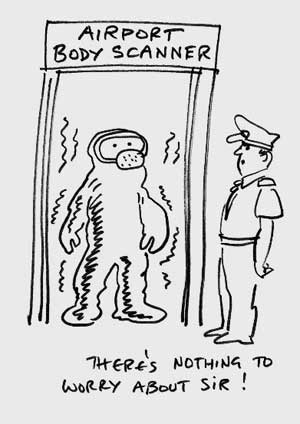|
|
|
|
While in one part of the US awareness of the dangers of radiation is growing – both Maine and California have recently taken to warning their citizens about overuse of mobile phones – elsewhere, such as in the Transport Security Agency (TSA), radiation is being ramped up for anyone who has to travel by air. And the US are not alone. UK transport secretary Lord Adonis was recently having to try and explain how it was that female staff at Heathrow, despite claims that images produced by the body scanners ‘are immediately deleted once the passenger has gone through the scanner’, had managed to get print outs of the complete body scan (genitals and all) of film star Shahrukh Khan who had just passed through the scanner. But while the papparrazzi are no doubt thrilled by the prospect of such juicy free material more responsible souls are worried about the significant doses of radiation which these new and extremely expensive scanners deliver. Questions are also being asked as to whether they will protect us any better than traditional methods (which have prevented any major event since 9/11) or whether they are merely guaranteeing massive pensions for the scanner industry. Moreover it appears that, while whole body scans might detect explosives stored in underpants, they may not sniff out those that had been implanted into the breasts, buttocks or appendixes of suicide bombers. Given that as little as 100grams of PETN can bring down an aircraft, according explosive experts at Porton Down, and that the explosive would be stored in a sealed plastic sachet, it is not certain that even whole body scanner, which only penetrates a few centimetres into the flesh, would actually ‘see’ it. So for a great deal of money and very little obvious gain we will be subjecting passengers, airline staff, and even worse, aircraft crews, to regular large doses of Xrays that officials and scanner makers claim are harmless – but are they? The late Dr John Gofman, Professor Emeritus of Molecular and Cell Biology, University of California, Berkeley and a leading expert on radiation from Hiroshima and Nagasaki to mammograms, believed that there is no safe dose level of ionizing radiation and that although there are medical conditions where the benefit of an Xray will out weigh the radiation risk, Xrays should be used extremely sparingly and at the lowest level possible. Ionizing radiation in the X-ray spectrum damages and mutates both chromosomal DNA and structural proteins in human cells. Recent research shows that even very low doses of X-ray can delay or prevent cellular repair of damaged DNA, raising questions about the safety of routine medical X-rays. Unborn babies can become grotesquely disfigured if their mothers are irradiated during pregnancy. Heavily X- rayed persons of childbearing age can sustain chromosomal damage, endangering offspring. Radiation damage is cumulative and each successive dose builds upon the cellular mutation caused by the last. It can take years for radiation damage to manifest pathology. As Dr Gofman says: ‘The fact, that X-ray doses are so seldom measured, reflects the false assumption that doses do not matter…[but] they do matter enormously. And each bit of additional dose matters, because any X-ray photon may be the one which sets in motion the high-speed, high energy electron which causes a carcinogenic or atherogenic [smooth muscle] mutation. Such mutations rarely disappear. The higher their accumulated number in a population, the higher will be the population’s mortality rates from radiation-induced cancer and ischemic heart disease.’ Dr Gofman’s work revealed a dose response relationship between medical Xrays and fatal heart disease. He found that X-radiation is a powerful atherogen, causing mutations in smooth muscle cells of coronary arteries. These radiation damaged cells are unable to process lipoproteins correctly, resulting in atherosclerotic plaques and mini tumors in the arteries. Radiation used to treat breast cancer can badly damage the heart. He also believed that medical radiation is a factor in 75% of breast cancer cases. Indeed a report in the Lancet noted that after breast mammograms were introduced in 1983, the incidence of ductal carcinoma (12% of breast cancer) increased by 328%, of which 200% was due to the use of mammography itself - although it has to be said that doses used in the early years of mammography were much higher than they are now. However, research indicates that breast tissue is extremely susceptible to radiation induced cancer, confirming the theory that mammograms can actually initiate the very cancers that they later identify. And although mammograms may identify tumours earlier than physical examination, there is no evidence that early identification improves eventual outcome. Mortality in breast cancer has been dropping since before screening began and is generally attributed to better treatment and not screening. But whatever your position on mammography, there is no doubt that the massive increase in the use of medical Xrays is just adding to the electro and radiation smog to which we are all being subjected and from which an increasing number of people are suffering. Adding yet further zapping to an already densely electro-smogged environment such as an airport may have significant health effects on those who use the airports and, far more worryingly, on those who fly our aeroplanes and who will subjected to the heaviest, because the most regular, doses of radiation.
More articles on electro sensitivity First Published in March 2010
|













